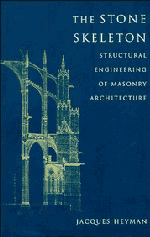5 - Some Structural Elements
Published online by Cambridge University Press: 05 August 2014
Summary
The wall
The three basic assumptions about the behaviour of masonry – no tensile strength, infinite compressive strength, no slip of the stones – have effectively eliminated material properties from the discussion. The previous chapters have attempted the analysis of arches, domes and vaults from, so to speak, a somewhat distant viewpoint; it is the overall shape of these structures, rather than their detailed construction, which controls structural action. Such geometrical considerations are also paramount for the study of the flying buttress made at the end of this present chapter, but a closer view must be taken of, for example, the wall, if its action (and its pathology) are to be understood.
Some elementary geometry is of course involved even in the idealization of a wall as a flat-sided slab of uniform thickness. It seems obvious, for example, that the wall must not be too thin compared with its height and length, and this intuition can be supported easily by rational argument. A thin wall may be built vertically and remain upright under the action of its own weight, but it must have some reasonable margin of safety against settlement and accidental tilt of its foundations. The centre of gravity of a cross-section of the wall must not move outside the verticals drawn through the limits of its base, and a certain minimum ratio of thickness to height will give the required margin.
Information
- Type
- Chapter
- Information
- The Stone SkeletonStructural Engineering of Masonry Architecture, pp. 83 - 108Publisher: Cambridge University PressPrint publication year: 1995
